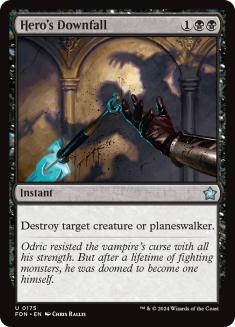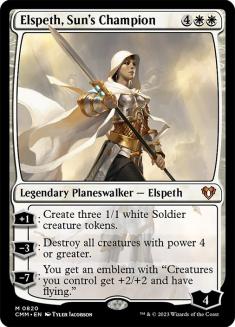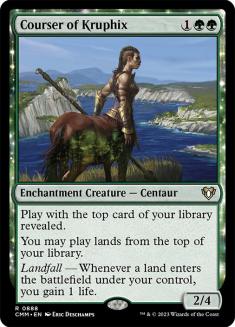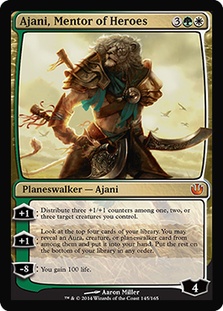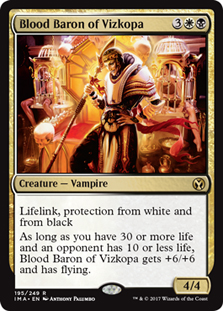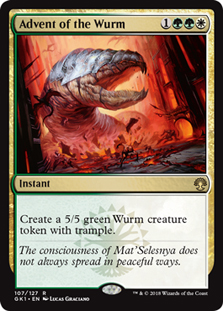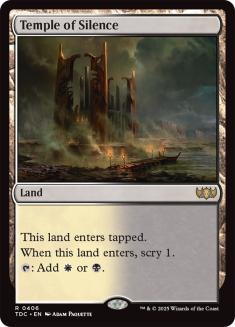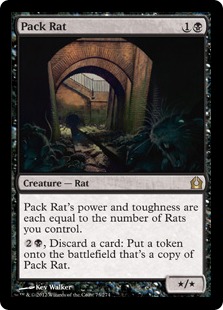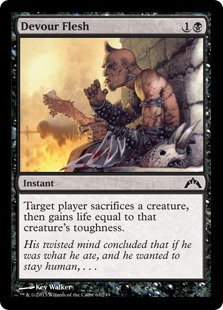Consider this:
You lead with two-drop, three-drop, four-drop on the play. Your opponent’s first play is a powerful four-drop. You Unsummon it, attack, and play another
creature.
How are they possibly going to win?
Obviously that’s the “dream” scenario, but it is really so unrealistic? We don’t typically mulligan hands with powerful cards, and what are the odds that
they have such an aggressive draw? The act of creating a narrative in which your keep (or play) makes sense is a dangerous one. We live in a volatile world
now. Missteps are brutally punished by overwhelmingly powerful cards–it’s not the good old days where you had six turns to draw an answer to Wild Mongrel.
A couple years ago, I posited that Unsummon is likely a better limited card than Murder. It was mostly a throwaway comment, but I expected some response to
it at the very least. Instead, no one said anything. How many games do you lose with powerful spells still in your hand? How many games do you lose
thinking “If I just had a little more time…”? In this day and age, I’m guessing it’s a lot.
Card advantage is no longer the most powerful strategy in Magic, and it hasn’t been that way in a while. Instead, we use cards like Ancestral Vision not to
grind our opponent out (although sometimes that’s the case) but to provide velocity, give us options, and close the door on a game where we we’re slightly
ahead. Underworld Connections should serve the same purpose.
Meanwhile, hard card-drawing like Opportunity sees little to no play. It’s just better to cast something like Elspeth, Sun’s Champion, which has an effect
on the board. There are lots of people that can beat an Opportunity but very few that can beat an Elspeth if it stays in play. Sphinx’s Revelation might be
the outlier here, but A) I don’t think it’s very good, and B) It also gains you life, which mitigates the tempo loss significantly.
Tempo is king, and as Adam Yurchick mentioned a while ago, Magic seems to be about who can empty their hand the fastest. Of course, that can be dangerous,
as there are cards that punish you for using a linear strategy, such as Supreme Verdict. However, if you emptied your hand with different threats, like
creatures and planeswalkers, then no single card can catch them back up outside of the incredibly slow Planar Cleansing.
Successful decks nowadays have a general game plan they stick to while also having a sprinkle of ways to interact with things that get in their way. Most
decks don’t focus on removing every threat because that’s too tall of an order. Even the control decks just slam Elspeth, Sun’s Champion and ride it to
victory.
Rapid Hybridization is not a “good” card, but it’s a card that turns Pack Rat, Desecration Demon, and Polukranos, World Eater into something far more
manageable. The Tidebinder Mage combo is great, but oftentimes unnecessary. Most of the time, all you need to do is make their creature that was in your
way not be in your way anymore.
So what’s the takeaway here? Virtual card advantage is the new card advantage.
In the above scenario, your opponent died with seven cards in their hand, while you only had one or two left. In that situation, you were up five or six
cards on your opponent simply by casting your spells in a more timely manner. In most games, the choke point, or scarce resource, isn’t card
advantage–it’s mana.
There is a reason that despite all the fancy splashes available to Mono-Black and Mono-Blue Devotion, they elect not to splash. Sure, you can splash and
still win tournaments, but if the question we’re asking is, “Are we the best deck we could be?” the answer is almost certainly no. When you’re playing with
20-21 basic lands and a low mana curve, you are going to get a lot of free wins by curving out while your opponent is fumbling around with temples.
I don’t want to risk having the Thoughtseize, Pack Rat, make a rat, Desecration Demon draw and having a temple mess up my progression. Decks like U/W
Control are in the market for an effect that scrys for one mana (without losing a card), but I can’t say the same is true for Mono-Black Devotion. You
might win some games by overkilling with a Gray Merchant for eight, but it’s those close games you eke out with Mutavault chip damage and a Gray Merchant
for four on the turn before you die that make you really appreciate not having temples in your deck.
“I mean, tight, but aggressive. And I do mean aggressive. That’s your style, professor.”
Consider this:
You’re playing Mono-Black Devotion and your first play is a turn 3 Lifebane Zombie off Swamp, Swamp, Mutavault against an opponent with a Temple of Plenty
and Temple of Malady in play. You see:
Who’s winning?
Obviously it can depend on your hand, but man their hand is stacked! Despite that, I find it difficult to believe that they could win this game if you have
anything else going on. They are not guaranteed to have a turn 3 play, you might have a follow-up, and they’ll be so far behind that I can’t imagine them
winning the game. That’s not even taking into account the mana issues they might have on subsequent turns.
It’s reasons like this that I think Sign in Blood takes priority over something like Underworld Connections. The games where you need something that allows
you to curve out, ala Ancestral Vision, over something that allows you to grind, such as Underworld Connections, are so much more often to happen. Of
course there are matchups like U/W Control where you’d want both if you could, but even in the mirror, I’d rather tap out every turn and never give them
time to start using Underworld Connections.
Overall, Sign in Blood is such a better card for the strategy that Mono-Black Devotion wants to be playing. It undoes mulligans, gives you the resources to
use your mana every turn, allows you to hit your curve more frequently, and it can even nug them for the last two points. What’s not to love? Mono-Black
Devotion should be aiming to end games as soon as possible, and to that end, Sign in Blood is a much better fit that Underworld Connections.
Connections is also useful with Gray Merchant of Asphodel, but I don’t think I’d be abandoning Connections entirely. There are definitely games where it
comes down to attrition, and I’d like to have an option to play that game if it comes to it. Closing the door on you having that option entirely seems
wrong, especially considering how much cutting Underworld Connections would weaken your Gray Merchants.
So, why do you think “be proactive” is the most common blanket advice for what deck to play in Standard? Because ultimately it’s true. Even if people don’t
understand the rationalization behind it, they still understand that being proactive is an important part of being successful in today’s world. The days of
countering every spell your opponent plays or killing every threat with removal just don’t exist because those strategies aren’t viable. Eventually
something is going to slip through the cracks that will be devastating.
I know there have been a lot of articles on Mono-Black Devotion since Theros’ release, but it applies here possibly more than anywhere else and that’s why
I keep coming back to it. There is a reason that Owen Turtenwald sides in Lifebane Zombie against Mono-Blue Devotion. Is it because you hope to snipe that
two-time Pro Tour Champion Judge’s Familiar from their hand?
Nope, it’s so you can #&%@ing attack them!
If you try to play the attrition game against Jund Monsters or Mono-Blue Devotion, eventually something like a Bident of Thassa or Xenagos, the Reveler is
going to show up and undo all the hard work you did while keeping their board clean. If you have a Lifebane Zombie and Mutavault hitting them while you’re
killing their important stuff, that closes the door faster and gives them less draw steps to find something that will turn the game back in their favor.
It’s not quite virtual card advantage though. Virtual card quality perhaps? Maybe we could call it “game advantage?” After all, if you’re at zero life, I
think I have game advantage.
Consider this:
In the Mono-Black Devotion mirror, do you keep or mulligan the following hand six card hand on the draw?
StarCityGames Legacy Open champion Kennen Haas asked, “Are our edges really large enough that we can afford to mulligan this type of hand?” My rationale
for keeping the hand would be more in line with what I was talking about earlier, but Haas brings up a very valid point. If the games are ending quicker
and we have less time to recover from stumbles, can we actually afford to “play it safe” and mulligan into a five card hand?
What are we hoping for–a two or three lander with some interaction? That might be an ideal situation, but the above six-card hand has a lot of tools to
both slow our opponent down and potentially allow us to cast Pack Rat on turn 5 or 6. If our first discard spell shows a hand that is weak to Pack Rat,
don’t be afraid to jam that into a potential topdecked removal spell. If you see blood in the water, go for it.
Pack Rat is one of those cards that further exacerbates the “issue” of tempo over card advantage. It punishes people who stumble and is an early threat
that continues to pile on the pressure turn after turn. Don’t be scared of having your good card die. Instead, you should be using it for its intended
purpose. If it does die, so be it.
Anyway, even our “ideal” five-card hand isn’t going to be wow-ing anybody. Your best bet is to keep this six and hope you get there. If not, take solace in
the fact that you made a correct decision, even if you had a low chance to win. Taking the 25% option is better than the 5% option.
“Playing it safe” often leads to playing around one thing that you shouldn’t be afraid of in the first place. Again, that false narrative of “I never draw
another land when I keep one-landers” isn’t true. Playing scared has never helped anyone. Make the highest EV decision at all points and ignore your fear.
U/W/R has been a deck in Modern since the format’s inception, but only now are we realizing that putting pressure on them might be the best way to do
things. Shaun McLaren did it with Kiki Jiki, Mirror-Breaker, but at Grand Prix Boston, a lot of people were doing it with Geist of Saint Traft. I believe
that type of strategy, no matter how you choose to execute it, is far better than grinding people out and eventually killing them with Celestial Colonnade.
It’s far more reasonable to expect that U/W/R can close a game by playing a Jund-like game, using removal to contain relevant threats while simultaneously
sneaking through damage with Snapcaster Mage or Geist of Saint Traft. In formats like Modern and Standard, the best way to utilize that strategy seems to
be by playing twelve-to-sixteen hard-hitting threats backed up by interaction.
Having things that hit hard, such as Desecration Demon, Tarmogoyf, and Geist of Saint Traft and having midrange elements seems to work better than playing
Steppe Lynx and Delver of Secrets. The decks with one-drops don’t topdeck well and don’t have the utility of playing a more controlling game when
necessary. More importantly, cards like Tarmogoyf can play offense and defense, allowing you to shift roles seamlessly.
I’m not sure what I expect from this article. I think there’s a lot of good information here but not a lot of ways to practically apply it outside of
limited, Mono-Black Devotion, and U/W/R. You could argue that even decks like Mono-Blue Devotion and U/W Control could use this to their advantage though.
I do think that an important turning point for Magic has occurred and potentially passed us all by.
I look back on how I built Faeries, Jund, Caw-Blade, Delver, and Mono-Black Devotion and cringe at how misinformed I was. Internalizing why things are the
way they are was helpful for me, as it gave me a fresh (and probably correct) view of deckbuilding as a whole. It’s also led me to try new things, such as
jamming one-drops in my limited decks. At Pro Tour Gatecrash, I played three Foundry Street Denizens in my 3-0 deck and in M15 limited, I’ve been playing a
lot of Soulmenders. It’s a little different there because convoke exists, but the extra damage matters early, the life gain helps if we get into a hard
racing situation, and cards like Sanctified Charge make them a lot better in the mid game.
Even if this won’t directly help you win your next tournament, if it gets you thinking about how deep Magic is and how you might be approaching things
incorrectly (just like I did), then I think I’ve done a good job. As for decklists and discussion on the new Standard, I’m sure we’ll have plenty to talk
about after Pro Tour Magic 2015 this weekend!

